
The Shang dynasty, also known as the Yin dynasty, was a Chinese royal dynasty founded by Tang of Shang that ruled in the Yellow River valley in the second millennium BC, traditionally succeeding the Xia dynasty and followed by the Western Zhou dynasty. The classic account of the Shang comes from texts such as the Book of Documents, Bamboo Annals and Records of the Grand Historian. Modern scholarship dates the dynasty between the 16th to 11th centuries BC, with more agreement surrounding the end date than beginning date.

Yinxu is the site of one of the ancient and major historical capitals of China. It is the source of the archeological discovery of oracle bones and oracle bone script, which resulted in the identification of the earliest known Chinese writing. The archeological remnants known as Yinxu represent the ancient city of Yin, the last capital of China's Shang dynasty which existed through eight generations for 255 years, and through the reign of 12 kings. Yinxu was discovered, or rediscovered, in 1899. It is now one of China's oldest and largest archeological sites, and was selected as a UNESCO World Heritage Site in 2006. Yinxu is located in northernmost Henan province near the modern city of Anyang, and near the Hebei and Shanxi province borders. Public access to the site is permitted.

The zun or yi, used until the Northern Song (960–1126) is a type of Chinese ritual bronze or ceramic wine vessel with a round or square vase-like form, sometimes in the shape of an animal, first appearing in the Shang dynasty. Used in religious ceremonies to hold wine, the zun has a wide lip to facilitate pouring. Vessels have been found in the shape of a dragon, an ox, a goose, and more. One notable zun is the He zun from the Western Zhou.
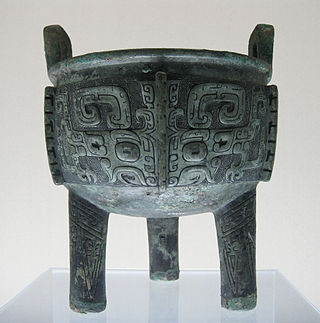
Ding (鼎) are prehistoric and ancient Chinese cauldrons, standing upon legs with a lid and two facing handles. They are one of the most important shapes used in Chinese ritual bronzes. They were made in two shapes: round vessels with three legs and rectangular ones with four, the latter often called fangding. They were used for cooking, storage, and ritual offerings to the gods or to ancestors. The earliest recovered examples are pre-Shang ceramic ding at the Erlitou site but they are better known from the Bronze Age, particularly after the Zhou deemphasized the ritual use of wine practiced by the Shang kings. Under the Zhou, the ding and the privilege to perform the associated rituals became symbols of authority. The number of permitted ding varied according to one's rank in the Chinese nobility: the Nine Ding of the Zhou kings were a symbol of their rule over all China but were lost by the first emperor, Shi Huangdi in the late 3rd century BCE. Subsequently, imperial authority was represented by the Heirloom Seal of the Realm, carved out of the sacred Heshibi; it was lost at some point during the Five Dynasties after the collapse of the Tang.
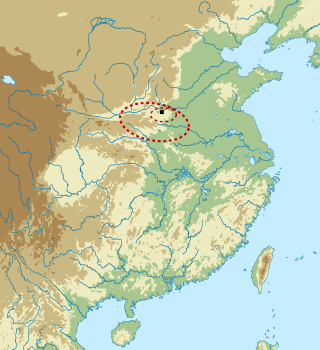

A guang or gong is a particular shape used in Chinese art for vessels, originally made as Chinese ritual bronzes in the Shang dynasty, and sometimes later in Chinese porcelain. They are a type of ewer which was used for pouring rice wine at ritual banquets, and often deposited as grave goods in high-status burial. Examples of the shape may be described as ewers, ritual wine vessels, wine pourers and similar terms, though all of these terms are also used of a number of other shapes, especially the smaller tripod jue and the larger zun.

The Tomb of Fu Hao is an archaeological site at Yinxu, the ruins of the ancient Shang dynasty capital Yin, within the modern city of Anyang in Henan Province, China. Discovered in 1976 by Zheng Zhenxiang, it was identified as the final resting place of the queen and military general Fu Hao, who died about 1200 BCE and was likely the Lady Hao inscribed on oracle bones by king Wu Ding and one of his many wives.

The Taotie is an ancient Chinese mythological creature that was commonly emblazoned on bronze and other artifacts during the 1st millennium BC. Taotie are one of the "four evil creatures of the world". In Chinese classical texts such as the "Classic of Mountains and Seas", the fiend is named alongside the Hundun, Qiongqi, and Taowu. They are opposed by the Four Holy Creatures, the Azure Dragon, Vermilion Bird, White Tiger and Black Tortoise. The four fiends are also juxtaposed with the four benevolent animals which are Qilin, Dragon, Turtle and Fenghuang.

Sets and individual examples of ritual bronzes survive from when they were made mainly during the Chinese Bronze Age. Ritual bronzes create quite an impression both due to their sophistication of design and manufacturing process, but also because of their remarkable durability. From around 1650 BCE, these elaborately decorated vessels were deposited as grave goods in the tombs of royalty and the nobility, and were evidently produced in very large numbers, with documented excavations finding over 200 pieces in a single royal tomb. They were produced for an individual or social group to use in making ritual offerings of food and drink to his or their ancestors and other deities or spirits. Such ceremonies generally took place in family temples or ceremonial halls over tombs. These ceremonies can be seen as ritual banquets in which both living and dead members of a family were supposed to participate. Details of these ritual ceremonies are preserved through early literary records. On the death of the owner of a ritual bronze, it would often be placed in his tomb, so that he could continue to pay his respects in the afterlife; other examples were cast specifically as grave goods. Indeed, many surviving examples have been excavated from graves.
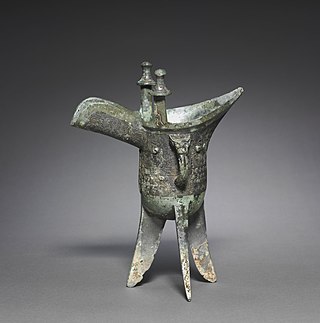
A jue is a type of ancient Chinese vessel used to serve warm wine during ancestor-worship ceremonies. It takes the form of an ovoid body supported by three splayed triangular legs, with a long curved spout on one side and a counterbalancing flange on the other. Many examples have one or two loop handles on the side and two column-shaped protuberances on the top of the vessel, which were probably used to enable the vessel to be lifted using leather straps. They are often ornately decorated with taotie decorations representing mythical beasts. They are in effect a small Chinese equivalent of the ewer. The name jue is not original, but derives from the Shuowen Jiezi, a dictionary of the 2nd century AD.

Shang archaeology is concerned with the archaeological evidence for the Chinese Shang dynasty. Choice of excavation sites and interpretation of finds have been heavily influenced by the textual historical record.

A hu is a type of wine vessel that has a pear-shaped cross-section. Its body swells and flares into a narrow neck, creating S-shaped profile. While it is similar to you vessel, hu usually has a longer body and neck. The shape of hu probably derives from its ceramic prototype prior to the Shang dynasty. They usually have handles on the top or rings attached to each side of neck. Many extant hu lack lids while those excavated in such tombs as Fu Hao's indicate that this type of vessel might be originally made with lids. Although it is more often to see hu having a circular body, there also appears hu in square and flat rectangular forms, called fang hu and bian hu in Chinese. In addition, hu often came to be found in a pair or in a set together with other types of vessels. As wine had played an important part in the Shang ritual, the hu vessel might be placed in the grave of an ancestor as part of ritual in order to ensure a good relationship with ancestor's spirit.
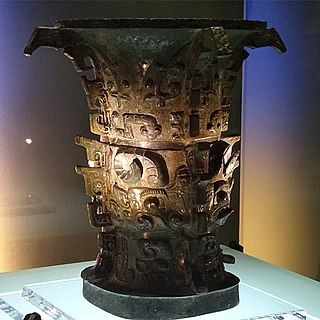
The He zun is an ancient Chinese ritual bronze vessel of the zun shape. It dates from the era of Western Zhou, specifically the early years of the dynasty, and is famous as the oldest artifact with the written characters meaning "Middle Kingdom" — 中國: "China" — in a bronze inscription on the container. Today it is in the Baoji Bronzeware Museum in Shaanxi.

A dui is a type of Chinese ritual bronze vessel used in the late Zhou dynasty and the Warring States period of ancient China. It was a food container used as a ritual vessel. Most dui consist of two bowls supported on three legs.

A gu is a type of ancient Chinese ritual bronze vessel from the Shang and Zhou dynasties. It was used to drink wine or to offer ritual libations.
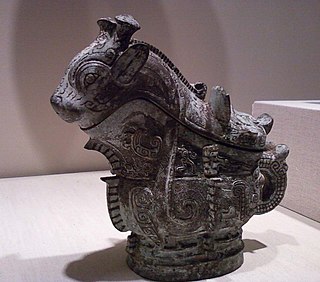
An elaborately decorated "ritual wine server" in the guang shape is a Chinese ritual bronze wine vessel, accession number 60.43, in the permanent Asian collection at the Indianapolis Museum of Art. It dates to about 1100 BCE in the Shang dynasty period. The piece is currently on display in the Arthur R. & Frances D. Baxter Gallery of the museum.

The Houmuwu ding, formerly called Simuwu ding, is a rectangular bronze ding of the ancient Chinese Shang dynasty. It is the heaviest piece of bronzeware to survive from anywhere in the ancient world. It was unearthed in 1939 in Wuguan Village, Anyang, Henan, near Yinxu, the site of the last Shang dynasty capital.
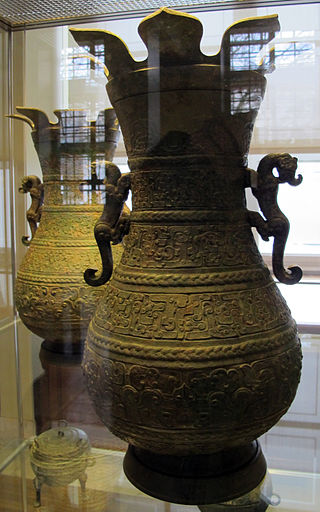
The Huixian Bronze Hu are a pair of bronze wine vessels that were found in the city of Huixian, Henan province, central China. Dating to the Eastern Zhou dynasty, they have been part of the British Museum's Asian Collections since 1972.

A fangyi is a type of Chinese ritual bronze container typical of the Shang and early to middle Zhou periods of Bronze Age China. It takes the shape of a square or rectangular casket with a cover that resembles a hip roof, surmounted by a knob of a similar hipped appearance. The lower edge is typically indented with a semi-circular notch.

The Luboshez guang is a Chinese ritual bronze wine vessel, dated to the 13th-12th century BC during the Shang dynasty that was auctioned off by Christie's during the annual Asia Week NY auctions of 2021 for a total of $8.6 million.




















